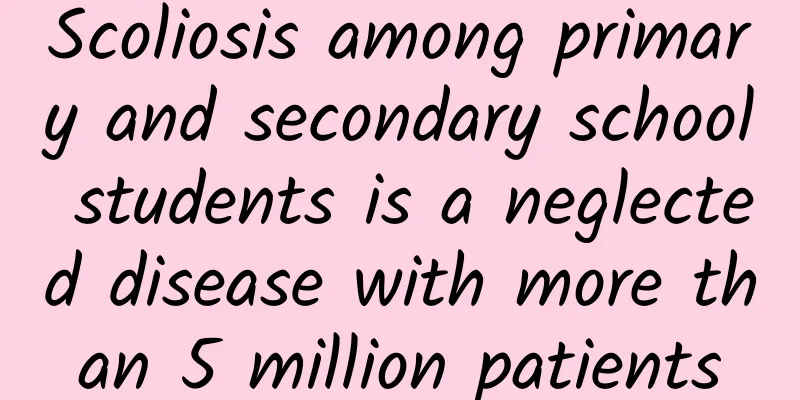Scoliosis among primary and secondary school students is a neglected disease with more than 5 million patients

|
Scoliosis has become the third most serious health hazard to children and adolescents in my country. What are the symptoms of scoliosis? How can we check and detect it in time? Written by reporter Lv Bingxin Photo and text editor: Chen Yongjie New Media Editor/Li Yunfeng [Interview with Expert] Sun Haolin (Chief Physician of Orthopedics Department, Peking University First Hospital, Member of the Professional Committee of Spine Disease Prevention and Control of the Chinese Preventive Medicine Association) Li Yanhu (Chief Physician of the Institute of Sports Medicine of the State Sports General Administration and Director of the Sports Health Medicine Research Center) In the past few years, almost every weekend, Ms. Xu would take her daughter from Dachang in the northern three counties to the rehabilitation hall of Peking University First Hospital, where the chief rehabilitation therapist Chen Hao would conduct special exercise rehabilitation training for scoliosis. Ms. Xu's daughter is 12 years old this year. Four years ago, she accidentally injured her sternum and was diagnosed with scoliosis. Before that, she knew nothing about this disease until the doctor told her how serious it was. However, this is not an isolated case among primary and secondary school students. In fact, after obesity and myopia, scoliosis has become the third largest disease that endangers the health of children and adolescents in my country. Let’s first look at a set of data. Preliminary epidemiological data from the Spine Disease Prevention and Control Committee of the Chinese Preventive Medicine Association show that the estimated number of primary and secondary school students in my country with scoliosis has exceeded 5 million, and is still increasing at a rate of about 300,000 per year. "Five million is a conservative estimate. Sometimes I go to a school with several thousand people and cannot find a single child with a healthy spine." In response to this data, Li Yanhu, chief physician of the Institute of Sports Medicine of the General Administration of Sport of China and director of the Sports Health Medicine Research Center, who has been engaged in research on adolescent spine health for many years, said frankly, "According to the data I have conducted nationwide surveys in recent years, the rate of spinal abnormalities among adolescents is more than half, and the proportion of scoliosis is at least around 10%." In sharp contrast to the shocking statistics is the neglect and lack of understanding among social groups such as students, parents and teachers. ○ ○ ○ Is the child just lazy because he doesn't stand properly? "How many times have I told you! Stand up straight, straighten your back, and don't be lazy." Ms. Sun didn't know how many times she reminded her son like this every day, but it was obvious that this reminder was ineffective. "It's so helpless. He still has a hunchback. It's useless to buy various braces and electronic correctors." Feeling something was wrong, Ms. Sun wondered how an 8-year-old boy could look so tired all the time. She eventually took her son to the hospital for a checkup and found that he had a 20-degree scoliosis. Sun Haolin, chief physician of orthopedics at Peking University First Hospital and member of the Professional Committee on Spine Disease Prevention and Control of the Chinese Preventive Medicine Association, said that this is the reason why many children "do not stand or sit properly", which is caused by structural scoliosis of the spine. ▲X-ray image of a scoliosis patient (Photo by Qin Tong) Sun Haolin introduced that under normal circumstances, the human spine should be in a straight line when viewed from behind, and the two sides of the trunk should be basically symmetrical. Scoliosis is a deformity caused by the spinal column deviating from the normal midline. In fact, it is accompanied by the rotation of the spine, which is like "twisting a knot". It is a three-dimensional structural deformity of the spine. The degree of scoliosis exceeding 10 degrees is usually defined as scoliosis. "Hunchback, uneven shoulders, tilted pelvis, long and short legs, one deep dimple on each side and one shallow dimple on the other, asymmetric shoulder blades, asymmetric thorax, razor back (when bending forward, the apex of the back on both sides is different)... these abnormalities in physical appearance are all clinical manifestations of scoliosis," said Sun Haolin. The Technical Guidelines for the Prevention and Control of Abnormal Spinal Curvature in Children and Adolescents compiled by the National Health Commission's Disease Control Bureau pointed out that scoliosis is mainly divided into non-structural scoliosis and structural scoliosis. Structural scoliosis is often true scoliosis, which is usually divided into idiopathic scoliosis and other types of scoliosis. Idiopathic scoliosis is the most common type of scoliosis in children and adolescents, accounting for about 75% to 80%, mainly in adolescent women. Unfortunately, the cause of idiopathic scoliosis is unknown and there is basically no definite cause. Sun Haolin told reporters, "Long-term poor posture, such as sitting crookedly or crossing your legs, may be risk factors. It is currently believed that the onset of idiopathic scoliosis may be related to family inheritance, biochemical factors, abnormal growth of muscles, bones and spine, and abnormal secretion of growth hormone." ○ ○ ○ It's too late when you find out the seriousness Like Ms. Xu's daughter, Ms. Sun's son's spinal health check-up was timely. Scoliosis within 20 degrees is considered mild, and the earlier it is discovered, the better the treatment effect. However, there are also children who have moderate or even severe scoliosis. It can be said that scoliosis is a quiet disease, and undercurrents have long been surging under the child's seemingly calm appearance. "Special attention should be paid to adolescence - the second peak of growth and development, which is the stage when scoliosis progresses relatively quickly." Sun Haolin said that if some teenagers are not treated in time, the degree of scoliosis can even increase by 10 degrees a year. Once it exceeds 40 degrees, the scoliosis will be very obvious from the appearance. Some may even affect the heart, lung, and nerve function, and surgery will be required. Sun Haolin said that if the scoliosis is within 20 degrees, it is difficult for parents to see it with naked eyes without careful observation, so many children only come to the hospital for treatment when the spinal abnormality is obvious at 30 degrees or even 40 degrees. Once the naked eye can find something wrong, the scoliosis is actually very serious. ▲Scoliosis screening standards for children (drawn by Qin Tong) Scoliosis not only affects the image and temperament, but also some scoliosis will worsen with the growth and development of adolescents. Once the degree develops to more than 40 degrees, it will have a great impact on the patient's physical and mental health. Because the greater the degree of scoliosis, the more significant the spinal imbalance, the abnormal appearance will seriously affect the appearance and cause psychological burden to the patient. The deformity can also cause long-term pain in the neck, chest, waist and back, limited chest movement and cardiopulmonary function, and even nerve compression, motor and sensory dysfunction of the lower limbs, etc. ○ ○ ○ Treatment should be continued throughout the developmental period The treatment of scoliosis is a long and complicated process that may even last throughout the entire developmental period. The treatment plan also varies depending on the location and angle of the scoliosis. Sun Haolin introduced that scoliosis of no more than 20 degrees can be treated with targeted exercise therapy. Scoliosis between 20 and 40 degrees requires brace treatment. Scoliosis above 40 degrees has a high chance of progression and requires surgical treatment. Specifically, sports therapy includes: swimming, hanging on the horizontal bar, orthopedic exercises and other targeted rehabilitation training. Brace treatment corrects scoliosis by wearing a brace to apply an inward squeezing force to the body. The brace weighs two to three kilograms and needs to be worn for more than 22 hours a day. "You have to wear it even when you sleep and you can't take it off even in the hot summer, so it's a process that requires teenagers to adapt and overcome specific difficulties." "At the beginning, the skin will be squeezed and become red and swollen, and even blisters will form. It is very difficult to live in such a hard shell for several years in a row." This is how a netizen who has experienced brace treatment described the pain. "Surgical treatment requires inserting steel plates and nails into the spine. Although it will have a great impact on the child's physical and mental health, the consequences may be more serious if left untreated," said Sun Haolin. ○ ○ ○ How to self-check and prevent at home? The key to scoliosis is prevention and early screening. The earlier it is detected, the better the treatment effect. Why is scoliosis more serious in children in remote areas? Sun Haolin said, "It is because it is discovered late, and early treatment and prevention are not timely enough." Parents in cities have a stronger sense of health, and health examinations in schools can also help to detect it earlier. In fact, the early detection of adolescent scoliosis mainly depends on parents, teachers and school doctors, and self-examination can be done with a simple bending test. ▲Self-examination of scoliosis in children (Chart by Qin Tong) First, ask the person being tested to take off his shirt, stand with feet together, knees straight, arms hanging naturally, palms together to prevent shoulder rotation, and bend forward 90 degrees. Parents or other examiners sit behind the child and look straight ahead to see whether the back of the child is at the same height. If one side is higher, it indicates that there may be scoliosis with bulge caused by vertebral rotation. Once abnormalities are found, the child should go to a regular hospital for orthopedic or related professional treatment in a timely manner. Sometimes changes in posture are hard to detect, but clothing abnormalities can be the first visible sign of scoliosis. For example: Is the hemline of your clothing uneven? Does one pant leg hang lower than the other? Does one sleeve appear longer than the other? Do the soles of your shoes wear to different degrees? Preventive measures for teenagers in their daily lives are also very important. Sun Haolin suggested that they should maintain the correct standing and sitting postures. Do not stand with your body tilted, cross your legs, or do homework with your body tilted. Secondly, mattresses should be made of medium to hard materials. Thirdly, proper physical exercise is also helpful for spinal health. Increasing the amount of exercise and improving muscle endurance can effectively improve the flexibility and mobility of the spine. ○ ○ ○ The whole society pays attention to the plight of adolescent scoliosis "The regrettable reality is that most parents and school teachers do not have enough knowledge about scoliosis. Reversing the plight of adolescent scoliosis requires the attention and efforts of the entire society," said Li Yanhu. However, some positive changes are also happening. For example, at the recent National People's Congress, some deputies proposed to promote and popularize adjustable desks and chairs in primary and secondary schools, so that each student can "customize" the height of the desk and chair according to their growth and development, and protect the students' spinal health. In fact, in order to strengthen the prevention and control of abnormal spinal curvature in children and adolescents, the "Technical Guidelines for the Prevention and Control of Abnormal Spinal Curvature in Children and Adolescents" organized and compiled by the National Health Commission's Disease Control Bureau was officially released in November last year to guide the standardized and scientific epidemiological prevention and control of abnormal spinal curvature in children and adolescents. The Technical Guidelines for the Prevention and Control of Spinal Curvature Abnormality in Children and Adolescents points out that it is necessary to regularly screen for spinal curvature abnormality in students, including incorporating spinal curvature abnormality screening into the physical examination for each school year or for new students. The results of spinal curvature abnormality screening should be included in the student health file to ensure that each student has a file, which can be transferred in real time as the student status changes. The spinal screening results of primary and secondary school students can be connected to dynamically monitor the health status of students' spines. In addition, it is also proposed that students themselves should actively cultivate the awareness that "everyone is the first person responsible for their own health" and take the initiative to learn and master spinal health knowledge and skills; families and schools should reduce students' academic burden in accordance with relevant national policies and standards, and regularly adjust the height of desks and chairs and the position of classroom seats according to the growth of children and adolescents, strengthen outdoor activities and physical exercise, cultivate and urge children and adolescents to develop a healthy lifestyle, and establish good behaviors to protect the spine. For some underdeveloped or relatively remote areas, it is proposed to promote initial screening mainly at home and in schools, and to establish a spinal health prevention and control platform to provide online consultation, so as to expand and improve the coverage and service capacity of spinal health prevention and control. To reduce the number of adolescent scoliosis patients and slow down the onset of scoliosis in children, it requires the active participation of every individual, family, school, medical and health care and other social forces, scientific cognition, scientific diagnosis and treatment. We hope that every sapling can grow into a straight tree. Related reading: Li Yanhu, chief physician of the Institute of Sports Medicine of the General Administration of Sport of China: Spinal health starts with correct posture Produced by: Science Central Kitchen Produced by: Beijing Science and Technology News | Beijing Science and Technology Media Welcome to share to your circle of friends Reproduction without authorization is prohibited |
<<: Beware! -- Drug-induced liver injury in children
Recommend
Pregnant women are prohibited from eating pine nuts
Pine nuts are a more common dried fruit in the No...
How much does a biopsy cost?
Speaking of cervical puncture biopsy, I believe t...
How to relieve hot palms and soles of pregnant women
The heat in the palms and soles of pregnant women...
Esophageal Cancer Patient Care Day | Are you at high risk for esophageal cancer? How to screen early? How to treat it?
▌The popular science theme of this article comes ...
How did Zhacai come about? Who invented it? What is Zhacai made of?
Zhacai is a type of mustard, generally referring t...
How can I make my nipples bigger?
For adolescent girls, there are many things to pa...
Can cold medicines be mixed together? Can pork rib soup supplement calcium? On World Hello Day, you should take good care of yourself from afar
To my youngest son who is working away from home:...
What is the reason for acne on the face during menstruation
Girls feel upset for a few days every month, and ...
How long after the curettage can I touch cold water?
In fact, the effects of uterine curettage and abo...
What is the cause of ovarian echo?
The ovaries are female-specific organs that mainl...
The little girl has heavy hair on her mouth
It is a very embarrassing situation for a girl to...
How many days does magnesium sulfate usually need to be infused to maintain pregnancy?
Pregnancy for women is a complicated process. If ...
What is the reason for bleeding after having sex after menstruation?
For female friends, any abnormal physical conditi...
What are some tips for choosing cabinets? What should I do if the cabinet door is moldy?
In the decoration process, like cabinets, there a...
How long does a course of chemotherapy for breast cancer last?
Breast cancer patients need to pay attention to p...









